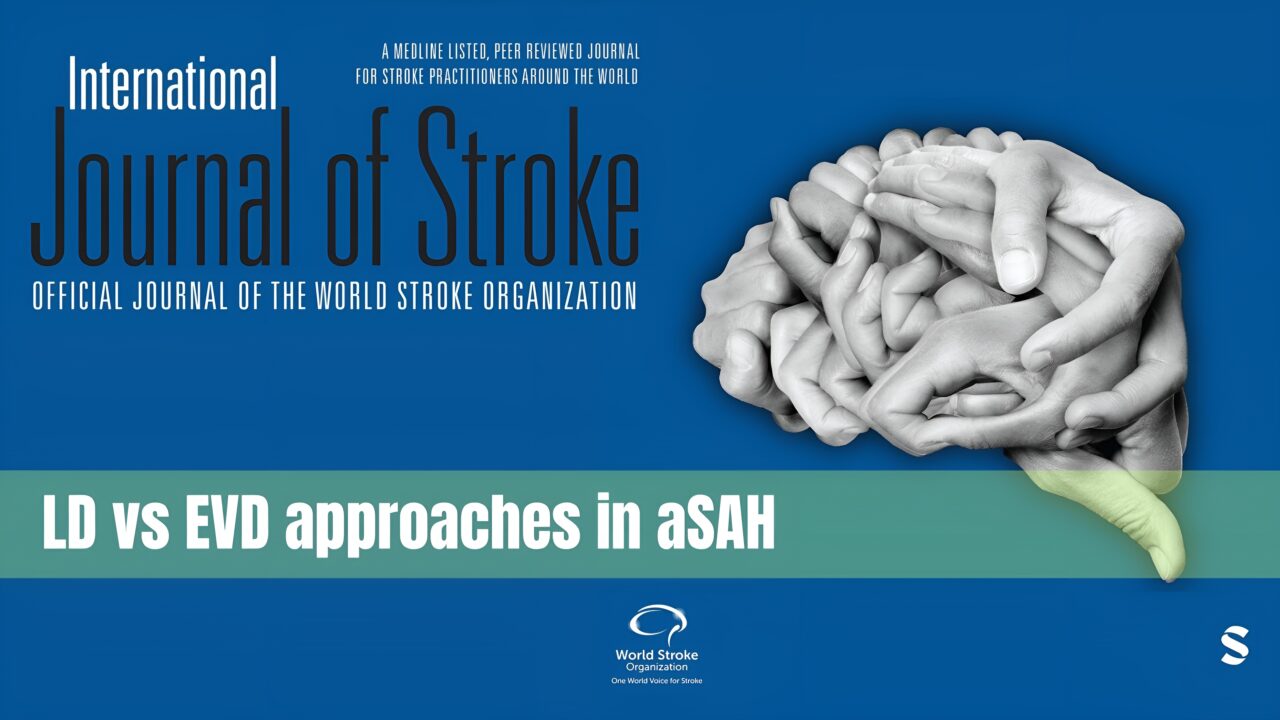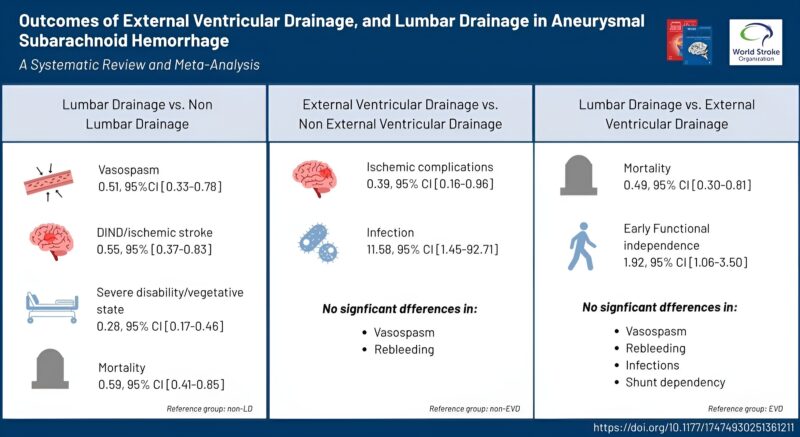
5 Reasons LD May Outperform EVD in aSAH: Is Lumbar Drainage the Superior Strategy?
International Journal of Stroke (IJS), official journal of World Stroke Organization, shared a newly piblished study on X:
”New systematic review and meta analysis compares outcomes of external ventricular drainage and lumbar drainage in aSAH. When directly compared, LD was favored to EVD for early functional independence and survival”
Read the full article here.
In patients with aneurysmal subarachnoid hemorrhage (aSAH), cerebrospinal fluid diversion via lumbar drainage (LD) or external ventricular drainage (EVD) plays a critical role in managing complications.
In the recently published comprehensive meta-analysis ‘‘Outcomes of External Ventricular Drainage, and Lumbar Drainage in Aneurysmal Subarachnoid Hemorrhage: A Systematic Review, and Meta-Analysis” by Basel Musmar, Pascal Jabbour et al. in the IJS, a comparative overview of LD and EVD approaches in aSAH is discussed.
- LD was associated with lower risks of vasospasm, ischemic complications, severe disability, and mortality without an increased risk of rebleeding.
- EVD effectively reduced ischemic events but carried a higher infection risk.
Direct comparisons suggest LD may offer advantages in early functional recovery and survival, though clinical context and patient severity remain key considerations.
Further research is warranted to guide optimal intervention strategies!

All the latest scientific advancements in the field of thrombosis and bleeding featured in Hemostasis Today.
-
Oct 25, 2025, 10:13Meet the 2025 WSO Award Winners for Their Extensive Contributions to Stroke Science
-
Oct 25, 2025, 09:53Aakanksha A Shares The 1st Post in ASH 12-Part Microlearning Series
-
Oct 25, 2025, 09:22Alessandro Bufi Presented SAIDE Project at World Stroke Congress 2025
-
Oct 25, 2025, 09:06A Short Story About a Platelet Named Pippa from Krista Goerger
-
Oct 25, 2025, 08:31Maxime Dely: What if We Could Leukoreduce Without a Filter?
-
Oct 24, 2025, 12:08Julián Alejandro Rivillas Compares Tenecteplase to Low-dose Alteplase: TRACE-5 Interim Phase II Results
-
Oct 24, 2025, 12:03Melissa Glasner on Integration of Gene Therapy Into Hemophilia Care
-
Oct 24, 2025, 11:41Yaping Zhang on Platelet Adhesion Receptors
-
Oct 24, 2025, 11:37Omid Jafari and Colleagues Present the VTE-BERT Natural Language Processing Model
-
Oct 24, 2025, 11:34Insights on IV Thrombolysis and Mechanical Thrombectomy from Benjamin Maier and Colleagues
-
Oct 23, 2025, 09:57Arun V. J: Artificial Blood Is Closer Than You Think
-
Oct 23, 2025, 07:11Sebastien Lobet Presented the ACTIVLIM-Hemo Scale
-
Oct 23, 2025, 07:05Syed Ehsan Shah on Advantages of Werfen HemoCell Automation
-
Oct 22, 2025, 08:25Johanna Nystedt: Not Every Day We Can Release a New Blood Product to Meet An Unmet Medical Need!
-
Oct 21, 2025, 06:58Arno Nierich: How Caffeine Affects Red Blood Cells and Blood Storage
-
Oct 25, 2025, 09:32Sylaja Pn Wins 2025 WSO Presidential Award
-
Oct 25, 2025, 08:21Courtney Lawrence: Listen. Empower. Deliver. Save Lives!
-
Oct 25, 2025, 08:14Hema Tallman on Incredible Opportunity to Participate in the PPTA 2025 Meetings
-
Oct 24, 2025, 11:28Louise Bannon and Thomas Reiser Thank World Thrombosis Day Supporters Around The World
-
Oct 24, 2025, 10:48Melanie Daniel Congratulates Mickael Rosa and Antoine Rauch on Winning Bernd R. Binder Prize
